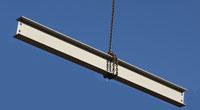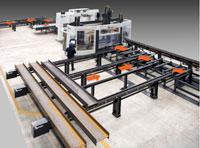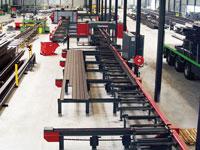Editor-in-Chief
- FMA
- The Fabricator
- FABTECH
- Canadian Metalworking
Categories
- Additive Manufacturing
- Aluminum Welding
- Arc Welding
- Assembly and Joining
- Automation and Robotics
- Bending and Forming
- Consumables
- Cutting and Weld Prep
- Electric Vehicles
- En Español
- Finishing
- Hydroforming
- Laser Cutting
- Laser Welding
- Machining
- Manufacturing Software
- Materials Handling
- Metals/Materials
- Oxyfuel Cutting
- Plasma Cutting
- Power Tools
- Punching and Other Holemaking
- Roll Forming
- Safety
- Sawing
- Shearing
- Shop Management
- Testing and Measuring
- Tube and Pipe Fabrication
- Tube and Pipe Production
- Waterjet Cutting
Industry Directory
Webcasts
Podcasts
FAB 40
Advertise
Subscribe
Account Login
Search
Where is structural steel material handling moving?
Structural shops need to rethink how material flows through the facility
- By Dan Davis
- August 3, 2012
- Article
- Automation and Robotics

Figure 1: When a structural steel beam is moved in a fabricating shop, all operators turn into spectators, watching the heavy beam as it travels slowly overhead and making sure they are out of harm’s way. These shops increasingly are turning to automated material handling systems to eliminate labor costs associated with transferring material from one station to the next.
Structural steel fabricating used to be thought of as a totally different world when compared to sheet metal fabricating. That’s not totally the case nowadays.
Sure, the material for the most part is different. (It’s hard to argue that when you compare the capabilities of a drill line with a laser cutting machine.) It’s the business environments that are similar, no matter where folks find themselves in the fabricating universe. Shops are looking to minimize labor costs while simultaneously attempting to address the impending retirement of valuable veteran workers.
Over the last decade the sheet metal world warmed up to the idea of automated material handling as a way to address those two major concerns. Many shops no longer pay machine operators to load blanks and unload parts, and with operators freed up from that mundane chore, they can spend time sharing their knowledge with newer workers. Pallet systems that continually whisk new blanks onto cutting tables and sophisticated tower systems that not only store a variety of blanks but also cut parts are regular sights at shops across North America.
But what about the structural steel shops? Although the adoption rate hasn’t been as high, their desire to acquire automated material handling equipment is growing stronger by the year (see Figure 1). The simple truth is that shops have to process beams more efficiently if they want to be more competitive in their bids.
Also, the layout specialists that play such an important role as the beams exit the machine tools are a dying breed. Mammas aren’t letting their babies grow up to be structural steel fabricators.
Automated material handling technology is helping some trailblazing shops to solve this dilemma (see Figure 2). These structural steel fabricators are increasing the tonnage of metal processed through the shop without adding resources. But before other shops start off on a similar trek in search of material handling efficiency, they need to keep a few things in mind.
A Measure of Things to Come
Automation can be introduced to just about any existing roller conveyor system. Electric motors replace hydraulic drivers, and electronics are put in place so that controls can automate material flow to a machine tool.
Getting modern material handling automation to work with older measuring equipment, such as gripper carriages, is almost an impossibility. Roller feed or roller measurement types of systems work best with faster-paced automation.
Measurement that is facilitated at the machine also lends itself to easy equipment relocation, according Nick Hajewski, marketing manager, Peddinghaus Corp. If the equipment had onboard measurement capabilities, new CNC machine tools can be moved into its place without needing to replace existing conveyors. This cuts down on the price of the new machine and has no impact on production accuracy. Older gripper- or cart-feed devices relied on machined gear racks.
“As soon as you start tearing apart an older measuring system by either removing some worn rack and then adding a new rack, you have calibration issues,” Hajewski said. “Also, by co-mingling an older gear rack and new gear rack, you have two surfaces that measure differently. When two different measurement surfaces come into play in a single part program, you are exposing yourself to the potential for error.”

Figure 2: With automated material handling, an operator can oversee multiple processes, not just material loading. Photo courtesy of Ficep Corp.
Adrian Morrall, president, Voortman Corp., recalled an equipment upgrade his company did for a structural steel fabricator in the mid-2000s. The company had a 30-year-old measuring system and a 1-year-old band saw at the time. Voortman technicians upgraded the band saw’s controls and added automated measuring capability to the equipment. At the same time, the fabricator purchased a drill line, which sat 60 feet away from the band saw. Automated material handling fed the band saw, where accurately measured beams were cut, and conveyors then fed the drill line. One operator now was supervising two machines, which in the past would have required at least two individuals and perhaps more depending on the pace of the drill line.
Buffering the Pain
Of course, for that type of structural steel fabricating system to work, the material handling has to be planned perfectly. As much as shop management may want to dictate how much steel exits the door, the machines on the shop floor determine the pacing of parts flowing through it (see Figure 3).
For example, a drill operates much faster than a band saw. To keep the drill operating at an acceptable rate, a fabricator might want to have a buffer of cut-to-length structural parts between the band saw and the drill. This allows the drill to churn out parts, and the band saw to keep operating at an optimal speed that doesn’t jeopardize the quality of the cuts.
Greg Carpenter, Peddinghaus’ systems project manager, added that planning is essential not only for current needs, but also for future plans. Good decisions made today will make changes in the future easier to implement.
“Some of our bigger customers want to see a five-year plan. They want to see what the system looks like now and how it can be expanded to meet their goals,” he said. “So when they put a piece of equipment in, they know where it is going to go and where the next piece of equipment is going to go.”
Rolling Right Into Place
With planning completed, it’s just a matter of moving equipment around and placing the conveyors and cross transfers where needed. Of course, the material handling equipment has to be suited for structural steel:
- Light-duty systems typically are able to handle up to 300 lbs. per foot, and heavy-duty systems up to about 800 lbs. per foot.
- The systems should have heavy-duty rollers, sprockets, and chains.
- The cross transfers should have lift cylinders large enough to handle the heaviest structural beams.
In some circumstances, a structural steel fabricator may want to specify a gap between adjacent roller sections. This arrangement makes adding a cross-transfer table a lot easier down the road.
Also, if a shop wants to move material off to either side of the cross transfer, it will require a much longer length of conveyor than if material were to be unloaded on only one side.
Those shops that simply can’t add on to the existing building might want to consider just adding a small shed to cover the machinery and placing the material handling system outdoors (see Figure 4). The heavy-duty construction of the conveyor rollers, supports, and other ancillary components makes them resistant to most harsh outdoor environments.
Looking at Lights-out Possibilities
The Holy Grail obviously is to run a system without human involvement—no operator is needed to load beams at the start of a cycle nor is one needed to operate the control and sequence the beams through a machine tool. That best-case scenario appears to be a reality for some structural steel fabricators.

Figure 3: A buffer is a necessity for a functional material handling system at a fab shop because not all machine tools operate at the same speed. Photo courtesy of Voortman.
“It’s kind of new, but it’s sort of a wake-up call for the industry,” said Tom Boyer, president, Ficep Corp.
Boyer said building information modeling (BIM), 3-D models used by all parties (architects, contractors, engineers, etc.) involved in the structural steel industry, has evolved to the point where it can be used to provide programming data for modern CNC machine tools. This programming isn’t limited to simple holemaking or coping; it can include scribing, such as for part numbers and layout information.
“This [automated fabricating process] starts off with a stock-length material, and it’s bar-coded into the system. And away it goes,” Boyer said. “As that piece processes through the line, the first cutoff operation knows what pieces come out of that stock length. As they are cut-to-length and drilled, depending on the configuration, we know what that piece is, and we route it through the material flow through the system based on subsequent required operations.”
Automated material handling acts as the traffic cop, ensuring that the beams move along to the stations where they are needed.
Martin Lachapelle, owner of Lainco Inc., Terrebonne, Quebec, Canada, can attest to the power of this lights-out approach. His company recently installed a Ficep 1001 DFB rotating spindle drill/saw line, upgraded the material handling feeding the system, and then watched his company’s productivity almost triple. Lainco’s 27 employees were processing an average of 80 tons per week prior to the installation; now the same number of people push about 200 to 250 tons per week.
The major difference, according to Lachapelle, has been that employees are more focused on loading and unloading trucks and feeding stock-length material into the magazine that feeds the drill/saw. The equipment measures and confirms the material stock length; loads the proper CNC program; drills; scribes; saws; and removes trim cuts, remnants, and finished lengths without the need of an operator.
Lachapelle added that at the end of a workday, the last thing they do is load up the magazine with stock-length beams. When they return the next day, the stock lengths have been turned into cut-to-length sections complete with holes and full four-side scribing ready for the fitters.
This type of information exchange is enhanced when the structural steel fabricator is able to incorporate the information into its ERP/MRP software. With the click of a button, the fabricator should be able to see where a particular beam is in production, what has been done to it, and when fabricating work on it will be complete. Depending on the level of information-sharing among project partners, someone such as a general contractor or an erector conceivably can click on the BIM and find out the status of a particular fabrication destined for the work site.
Indeed, automated material handling in the structural steel industry isn’t only about conveyors and cross transfers. It involves advanced machinery and dynamic software tools. It also isn’t done evolving.
Imagine a conveyor leaving the scribing station and feeding a welding area. A robot feeds the beam into a fixture and another robot begins the welding process. A vision system guides the torch, ensuring the proper amount of wire is fed into the inconsistent gaps often found on structural steel beams. When welding is complete, a robot moves the beam to a staging area, ready to be moved on to fitting. The process repeats itself again.

Figure 4: Sometimes structural steel shops don’t have enough space to add material handling equipment underneath the roof. In this photo, a powered conveyor feeds material into two drill and saw lines within the outbuilding. Photo courtesy of Peddinghaus.
Admittedly, machine tool builders say work remains to be done in this area, but the control software and vision systems are improving at a rapid pace.
“The first person that can crack the software and put this package together with the robotic welding will be on to something huge,” Morrall said.
That’s another area of potential good news for structural fabricators. Just as they struggle to hire experienced layout personnel, they can’t find welders either.
About the Author

Dan Davis
2135 Point Blvd.
Elgin, IL 60123
815-227-8281
Dan Davis is editor-in-chief of The Fabricator, the industry's most widely circulated metal fabricating magazine, and its sister publications, The Tube & Pipe Journal and The Welder. He has been with the publications since April 2002.
Related Companies
subscribe now

The Fabricator is North America's leading magazine for the metal forming and fabricating industry. The magazine delivers the news, technical articles, and case histories that enable fabricators to do their jobs more efficiently. The Fabricator has served the industry since 1970.
start your free subscription- Stay connected from anywhere

Easily access valuable industry resources now with full access to the digital edition of The Fabricator.

Easily access valuable industry resources now with full access to the digital edition of The Welder.

Easily access valuable industry resources now with full access to the digital edition of The Tube and Pipe Journal.
- Podcasting
- Podcast:
- The Fabricator Podcast
- Published:
- 04/16/2024
- Running Time:
- 63:29
In this episode of The Fabricator Podcast, Caleb Chamberlain, co-founder and CEO of OSH Cut, discusses his company’s...
- Trending Articles
AI, machine learning, and the future of metal fabrication

Employee ownership: The best way to ensure engagement

Steel industry reacts to Nucor’s new weekly published HRC price

How to set a press brake backgauge manually

Capturing, recording equipment inspection data for FMEA

- Industry Events
16th Annual Safety Conference
- April 30 - May 1, 2024
- Elgin,
Pipe and Tube Conference
- May 21 - 22, 2024
- Omaha, NE
World-Class Roll Forming Workshop
- June 5 - 6, 2024
- Louisville, KY
Advanced Laser Application Workshop
- June 25 - 27, 2024
- Novi, MI


























